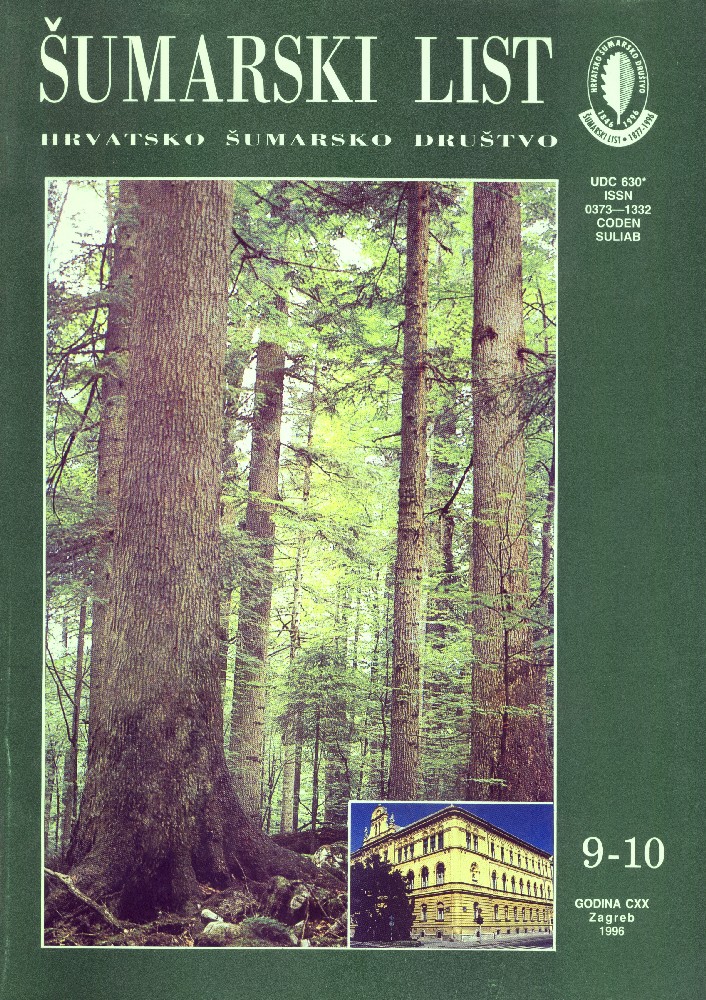
broj: 9-10/1996
pdf (12,9 MB) |
|
||||||||||||||
| UVODNI ČLANCI | ||
| Matić, S. | ||
| The 150th Anniversary of the Croatian Forestry Society PDF | 387 | |
| Prpić, B. | ||
| The 120th Anniversary of the Forestry Journal PDF | 391 | |
| IZVORNI ZNANSTVENI ČLANCI | ||
| Glavač, V. M. | UDK 630* 161.48.001 (497.13) | |
| On Blood Analysis of Forest Trees pdf HR EN | 393 | |
| Krpan, A. B. R., Petreš, S., Poršinsky, T. | UDK 630* 822 : 469.001(497.13) | |
| Research on the War-inflicted Damage on the Sessile-Flowered Oak and Beech Timber pdf HR EN | 399 | |
| Summary: In the Lipovljani sawmill 56 sessile-flowered oak logs and 63 beech logs were examined. The mean log diameters were 33.3 cm and 40.6 respectively. The oak length was 4.1 m, beech 4.5 m, mean volume 0.36 m3 and 0.58 m3 respectively. The prevailing number of injuries (65.4 %) upon oak logs are located along the first two length meters above groung, while 51.3 % of the damage is likewise located on beech logs. Although log samples were chosen in the sawmill, without knowing their original location in the trunk, it is clear that most logs were processed from the bottom trunk parts. The number of damage is mostly one, followed by two and three injuries per one log. One to three injuries were found on 82.0 % of oak logs, 71.4 % on beech. Ten injuries on one log has so far been the biggest number of injuries. In the oak logs we found 133 foreign bodies, of which 91.7 % were the most harmful metal projectile fragments. Steel balls from the VBR-projectiles were 3.8 "/<>, infantry ammunition 4.5 %. In beech logs there were 185 foreign bodies, of which 86.5 % were projectile fragments, 10.8 % balls and 2.7 % ammunition. Average fragment size was 10.9 x 8.4 mm; ball diameter 10.0 mm; ammunition 7.62 mm. The depth of penetration in the oak timber was between 30 mm and 135 mm, or average 71 mm; in beech logs, the depth ranged from 10 mm to 150 mm, average 49.6 mm. Total volume of oakwoodsections was 0.266 m3, beechwood 0.299 m-\ The section volume is 1.1 % of the net volume of both wood species. The depth of penetration according to the valid standards for roundwood may influence the timber quality, i.e. cause classification decrease. In 216 injuries close to the metal foreign objects, we noticed change in wood colour followed by various phases of wood rot. On 51 injuries, there was only one change of colour. Oak timber injuries were all attacked by fungi, while on beech logs 13 injuries were without visible destruction. The depth of penetration was mostly within allowed limits of the valid standards of mechanical injuries, therefore was the deterioration mostly associated with fungi. The average financial loss due to quality decrease was 13.7 % of log value according to the minimum price-list of the "Croatian Forests " Co. is necessary to establish the real forest area per age classes that are damaged in war, and more precisely estimate the damaged wood volume in mature and selection felling areas. The task is to remove the damaged units from the production so that the remaining stand could accumulate quality increment, avoiding long-term losses in felling and primary wood conversion. In terms of financial means, activities should be directed to international organizations and home users. Wood processors should accept timber from war-damaged stands and use them in the best sible way. Thus would total loss in the wood-processing complex be smaller. | ||
| Filipan, T., Prpić, B., Ružinski, N. | UDK 630* 114.2 : 114.5 : 161.48.001(497.13) | |
| Damage Caused by Excessive N-compaunds in Forest Ecosystems and Drinking Water Supply pdf HR EN | 411 | |
| Cerovečki, Ž. | UDK 630* 188.001 (497.13) | |
| Thermophylus Beech Forests of Ivanščica Mountan in Croatia pdf HR EN | 419 | |
| PREGLEDNI ČLANCI | ||
| Kranjčev, R. | UDK 630*145.7:181(497.13) | |
| Protected nature - The Sands of the Drava Basin Today pdf HR EN | 425 | |


